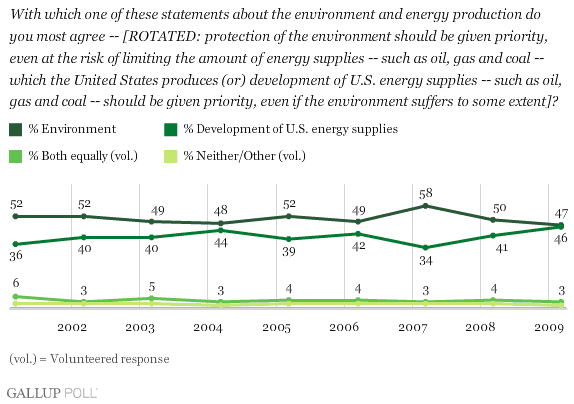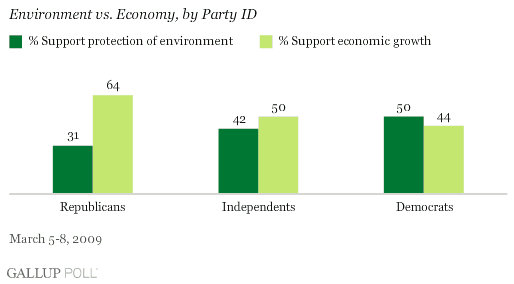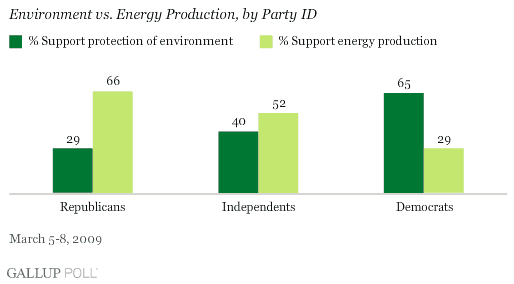PRINCETON, NJ -- For the first time in Gallup's 25-year history of asking Americans about the trade-off between environmental protection and economic growth, a majority of Americans say economic growth should be given the priority, even if the environment suffers to some extent.

Gallup first asked Americans about this trade-off in 1984, at which time over 60% chose the environmental option. Support for the environment was particularly high in 1990-1991, and in the late 1990s and 2000, when the dot-com boom perhaps made economic growth more of a foregone conclusion.
The percentage of Americans choosing the environment slipped below 50% in 2003 and 2004, but was still higher than the percentage choosing the economy. Sentiments have moved up and down over the last several years, but this year, the percentage of Americans choosing the environment fell all the way to 42%, while the percentage choosing the economy jumped to 51%.
The reason for this shift in priorities almost certainly has to do with the current economic recession. The findings reflect many recent Gallup results showing how primary the economy is in Americans' minds, and help document the fact of life that in times of economic stress, the public can be persuaded to put off or ignore environmental concerns if need be in order to rejuvenate the economy.
The Economy Versus Energy
Although the importance of energy as a policy concern in Americans' minds has moderated since last summer's high gas prices, a different trade-off question shows that Americans are more inclined now than in past years to favor giving the priority to energy production over the environment.
The question, which Gallup has used in this format since 2001, asks Americans whether they favor protection of the environment at the risk of limiting energy supplies, or favor the development of U.S. energy supplies at the risk of harming the environment. Respondents this year are essentially equally likely to choose the environmental option as they are to choose the energy production option, marking -- albeit by just one or two percentage points -- the highest percentage choosing energy and the lowest percentage choosing the environment in the nine years of asking the question.

There are, predictably, significant partisan differences in the responses to these trade-off questions.

As can be seen in the accompanying graph, only 50% of Democrats, who typically have been the most environmentally oriented in their policy positions, opt for the environmental protection position -- just six points higher than the percentage of Democrats choosing economic growth. (Republicans and independents are more likely to choose economic growth.) This finding suggests that the economic crisis may present a real philosophical dilemma to those who ordinarily are strongly supportive of environmental protection, but who may back off in the face of the perceived need to restore economic growth.
The partisan spread is somewhat larger for the trade-off question dealing with energy and the environment. Republicans and Democrats are almost perfect mirror images of each other in response to this question, with two-thirds of Republicans opting for energy over the protection of the environment, while two-thirds of Democrats hold the opposite view.

Bottom Line
There is little question that the current economic crisis poses a significant challenge for the environmental movement in this country. Previous Gallup research has shown that concern about global warming has diminished this year, and the research reviewed here shows clearly that Americans are more willing than ever to forgo protection of the environment if needed in order to ensure economic growth or the production of energy. With the economy as bad as it has been in recent memory, Americans' preferences have swung even more strongly in the direction of the economy over the environment.
Survey Methods
Results are based on telephone interviews with 1,012 national adults, aged 18 and older, conducted March 5-8, 2009. For results based on the total sample of national adults, one can say with 95% confidence that the maximum margin of sampling error is ±3 percentage points.
Interviews are conducted with respondents on land-line telephones (for respondents with a land-line telephone) and cellular phones (for respondents who are cell-phone only).
In addition to sampling error, question wording and practical difficulties in conducting surveys can introduce error or bias into the findings of public opinion polls.
